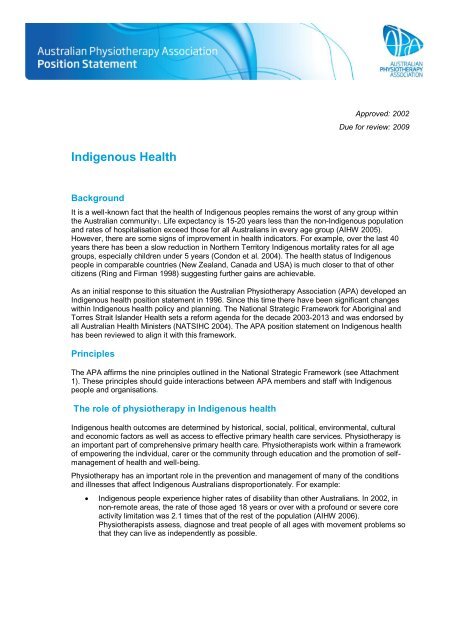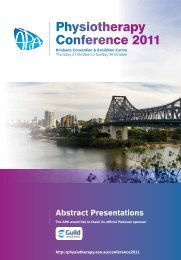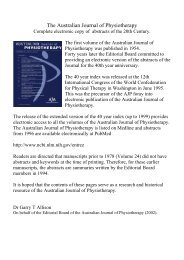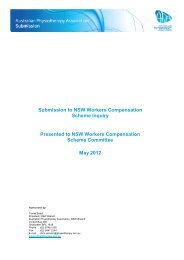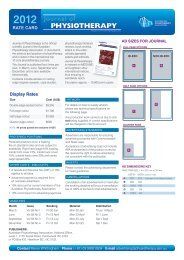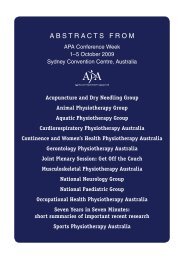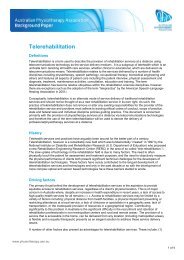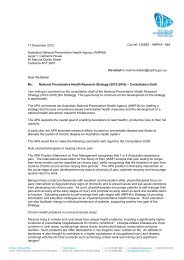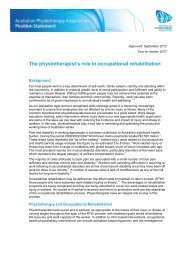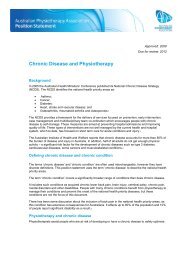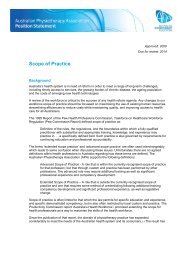Indigenous Health - Australian Physiotherapy Association
Indigenous Health - Australian Physiotherapy Association
Indigenous Health - Australian Physiotherapy Association
You also want an ePaper? Increase the reach of your titles
YUMPU automatically turns print PDFs into web optimized ePapers that Google loves.
Approved: 2002<br />
Due for review: 2009<br />
<strong>Indigenous</strong> <strong>Health</strong><br />
Background<br />
It is a well-known fact that the health of <strong>Indigenous</strong> peoples remains the worst of any group within<br />
the <strong>Australian</strong> community1. Life expectancy is 15-20 years less than the non-<strong>Indigenous</strong> population<br />
and rates of hospitalisation exceed those for all <strong>Australian</strong>s in every age group (AIHW 2005).<br />
However, there are some signs of improvement in health indicators. For example, over the last 40<br />
years there has been a slow reduction in Northern Territory <strong>Indigenous</strong> mortality rates for all age<br />
groups, especially children under 5 years (Condon et al. 2004). The health status of <strong>Indigenous</strong><br />
people in comparable countries (New Zealand, Canada and USA) is much closer to that of other<br />
citizens (Ring and Firman 1998) suggesting further gains are achievable.<br />
As an initial response to this situation the <strong>Australian</strong> <strong>Physiotherapy</strong> <strong>Association</strong> (APA) developed an<br />
<strong>Indigenous</strong> health position statement in 1996. Since this time there have been significant changes<br />
within <strong>Indigenous</strong> health policy and planning. The National Strategic Framework for Aboriginal and<br />
Torres Strait Islander <strong>Health</strong> sets a reform agenda for the decade 2003-2013 and was endorsed by<br />
all <strong>Australian</strong> <strong>Health</strong> Ministers (NATSIHC 2004). The APA position statement on <strong>Indigenous</strong> health<br />
has been reviewed to align it with this framework.<br />
Principles<br />
The APA affirms the nine principles outlined in the National Strategic Framework (see Attachment<br />
1). These principles should guide interactions between APA members and staff with <strong>Indigenous</strong><br />
people and organisations.<br />
The role of physiotherapy in <strong>Indigenous</strong> health<br />
<strong>Indigenous</strong> health outcomes are determined by historical, social, political, environmental, cultural<br />
and economic factors as well as access to effective primary health care services. <strong>Physiotherapy</strong> is<br />
an important part of comprehensive primary health care. Physiotherapists work within a framework<br />
of empowering the individual, carer or the community through education and the promotion of selfmanagement<br />
of health and well-being.<br />
<strong>Physiotherapy</strong> has an important role in the prevention and management of many of the conditions<br />
and illnesses that affect <strong>Indigenous</strong> <strong>Australian</strong>s disproportionately. For example:<br />
<br />
<strong>Indigenous</strong> people experience higher rates of disability than other <strong>Australian</strong>s. In 2002, in<br />
non-remote areas, the rate of those aged 18 years or over with a profound or severe core<br />
activity limitation was 2.1 times that of the rest of the population (AIHW 2006).<br />
Physiotherapists assess, diagnose and treat people of all ages with movement problems so<br />
that they can live as independently as possible.
In 2004-05, 33% of <strong>Indigenous</strong> peoples reported musculoskeletal conditions, including<br />
arthritis at 17% (AIHW 2006). <strong>Physiotherapy</strong> is an essential discipline in the prevention and<br />
management of these conditions.<br />
In 2004-05, <strong>Indigenous</strong> peoples had a high prevalence of respiratory diseases (30%),<br />
diabetes (12%) and circulatory problems (22%) (AIHW 2006). There is a significant body of<br />
evidence relating to the effectiveness and cost efficiency of physiotherapy in the<br />
management of chronic conditions such as these.<br />
<strong>Physiotherapy</strong> has an integral role in a wide variety of other areas such as rehabilitation after injury,<br />
child health, gender-specific health issues and assisting older people. Physiotherapists also help<br />
people prevent injuries and maintain fitness.<br />
Physiotherapists can provide services to <strong>Indigenous</strong> peoples in a range of contexts (urban, regional<br />
and remote) and settings (including hospitals, private physiotherapy practices, community health<br />
services, sport facilities, schools, workplaces, aged care facilities and outreach services for remote<br />
communities).<br />
Despite the potential for physiotherapy to improve <strong>Indigenous</strong> health outcomes, there are major<br />
gaps in access to physiotherapy services. Where services do exist, there is often limited utilisation<br />
by <strong>Indigenous</strong> peoples, particularly in the private sector (APA 2005). Aboriginal Community<br />
Controlled <strong>Health</strong> Services are the preferred and most culturally appropriate organisations to deliver<br />
health services to <strong>Indigenous</strong> people, but access to physiotherapy in these organisations is poor and<br />
needs to be improved (APA 2005). A 2001 survey of the 1216 discrete <strong>Indigenous</strong> communities,<br />
mainly in remote Australia, found that 60% had no access to physiotherapists (ABS & AIHW 2003).<br />
There is no comparable data on access to physiotherapists by the majority of <strong>Indigenous</strong> people<br />
who live outside these communities.<br />
Factors such as distance from services, availability of transport, availability of culturally appropriate<br />
services, workforce shortages and private health insurance cover affect access to, and use of,<br />
health services (APA 2005). <strong>Indigenous</strong> participation in service delivery also impacts on access. As<br />
in other health-related professions, <strong>Indigenous</strong> people are under-represented in the physiotherapy<br />
workforce. In 2001 there were 29 <strong>Indigenous</strong> physiotherapists – 0.3% of all physiotherapists (ABS &<br />
AIHW 2005).<br />
Improving access to physiotherapy for <strong>Indigenous</strong> <strong>Australian</strong>s<br />
The APA is committed to working for the better health of the <strong>Australian</strong> <strong>Indigenous</strong> population. The<br />
<strong>Association</strong> places particular importance on greater accessibility to and utilisation of culturally<br />
appropriate physiotherapy services. In line with the National Strategic Framework for Aboriginal and<br />
Torres Strait Islander <strong>Health</strong>, the APA supports:<br />
<br />
Resource allocation that reflects greater <strong>Indigenous</strong> health need;<br />
<br />
<br />
<br />
<br />
Improved access to physiotherapy for <strong>Indigenous</strong> peoples as part of comprehensive primary<br />
health care;<br />
Increased <strong>Indigenous</strong> participation in planning and management and of physiotherapy<br />
services and increased support for community controlled health services who want to<br />
provide physiotherapy services;<br />
The need to increase the number of <strong>Indigenous</strong> peoples working as physiotherapists;<br />
The need to equip physiotherapists with the appropriate skills and knowledge to meet the<br />
needs of <strong>Indigenous</strong> peoples;<br />
www.physiotherapy.asn.au<br />
2 of 3
The need to identify the most important evidence gaps and an approach to improving<br />
information that monitors how well the profession is meeting the needs of <strong>Indigenous</strong><br />
peoples.<br />
To this end the APA actively seeks ongoing collaboration with <strong>Indigenous</strong> organisations and<br />
communities to develop priorities and mechanisms for enhanced physiotherapy involvement. The<br />
APA will also develop partnerships with other health care providers and with other sectors that<br />
impact on <strong>Indigenous</strong> health.<br />
References:<br />
<strong>Australian</strong> Bureau of Statistics & <strong>Australian</strong> Institute of <strong>Health</strong> and Welfare (2005): The health and<br />
welfare of Australia’s Aboriginal and Torres Strait Islander peoples 2005, ABS cat. no. 4704.0, ABS,<br />
Canberra.<br />
<strong>Australian</strong> Bureau of Statistics & <strong>Australian</strong> Institute of <strong>Health</strong> and Welfare (2003): The <strong>Health</strong> and<br />
Welfare of Australia’s Aboriginal and Torres Strait Islander Peoples. ABS cat. no.4704.0, ABS,<br />
Canberra.<br />
<strong>Australian</strong> Institute of <strong>Health</strong> and Welfare (2006): Australia’s <strong>Health</strong> 2006, AIHW cat. no. AUS 73,<br />
AIHW, Canberra.<br />
<strong>Australian</strong> <strong>Physiotherapy</strong> <strong>Association</strong> (2005): <strong>Physiotherapy</strong> for <strong>Indigenous</strong> <strong>Australian</strong>s in rural and<br />
remote areas: A survey report, APA, Melbourne.<br />
Condon J, Barnes T, Cunningham J and Smith L (2004): Improvements in <strong>Indigenous</strong> mortality in<br />
the Northern Territory over four decades. <strong>Australian</strong> and New Zealand Journal of Public <strong>Health</strong> 28:<br />
445–451.<br />
National Aboriginal and Torres Strait Islander <strong>Health</strong> Council (NATSIHC) (2004) National Strategic<br />
Framework for Aboriginal and Torres Strait Islander <strong>Health</strong>: Framework for action by Governments,<br />
Commonwealth of Australia, Canberra.<br />
Ring IT and Firman D (1998): Reducing indigenous mortality in Australia: Lessons from other<br />
countries. Medical Journal of Australia 169: 528–533.<br />
www.physiotherapy.asn.au<br />
3 of 3


